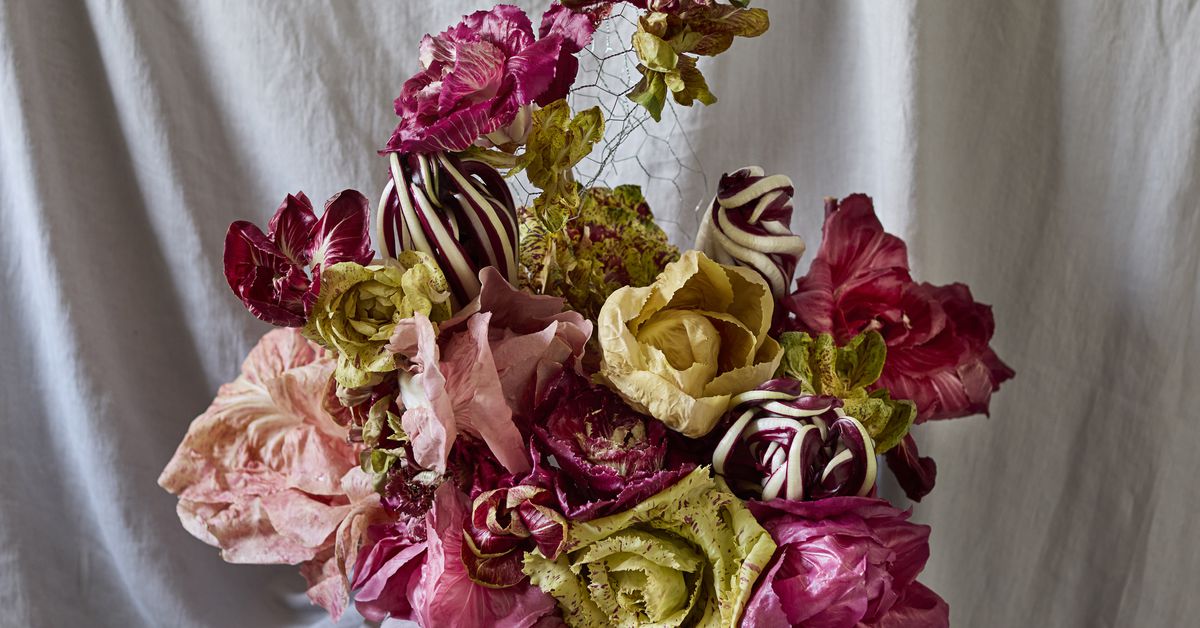
Not long ago, I went to a mushroom-themed musical dinner. The entire meal featured mushrooms, from the white snow fungus in the welcome drinks to the shiitakes in the sweet mushroom pavlova (surprisingly good!). Naturally, before any dishes even hit the table, mushrooms appeared there too; frilly clusters of oyster mushrooms anchored arrangements that were otherwise sparsely poked with greenery and just a flower or two. It brought to life what I’d been long coveting on my Instagram feed: bouquets made up primarily of vegetables and mushrooms, with flowers present but taking a supporting role.
The most prominent example of this is the Los Angeles floral designer Yasmine Mei, who describes her work as “playfully combining the classical and the unusual.” Her arrangements include pomegranates surrounding pink oysters and pom poms of lion’s mane, fluffy tufts of flowers interspersed with enokis, and thick trumpets nestled into a bouquet with herbs. A design featuring mushrooms along with underripe tangerines and stalks of yellow grevillea, also known as spider flowers, offers an otherworldly appearance. Her arrangements are having a moment, appearing at a recent event by Salad Freak author Jess Damuck and at another with designer Stella McCartney. “You, too, can fungify your centerpiece,” Smallhold, the rapidly growing supplier whose mushrooms are often used artistically, wrote in an Instagram post sharing Mei’s arrangement.
It isn’t just mushrooms starring in these refreshingly unpredictable designs. A splash of white currants turn a single pitcher plant into a centerpiece in an arrangement from London florist Kasia Borowiecka, who has also used tropical fruit, as well as kale and bitter melon, to great textural effect. Sparse designs from the Limassol, Cyprus artist Anastasia Kolesnichenko find sculptural beauty in arrangements as simple as a single star fruit paired with a slice of citrus and two flowers; so do designs from Berlin floral designer Carolin Ruggaber, who anchors arrangements with grapes or lemons. A “nutso midcentury Christmas kitsch spread” by the food artist Jen Monroe and the brand House & Parties included a tower of white asparagus, wrapped with pink ribbons. These aren’t your typical Edible Arrangements, but art that highlights the beauty in what happens to be edible.
Natoora, the purveyor of specialty produce, makes a compelling case for the vegetable bouquet each Valentine’s Day. With its “Radicchio, Not Roses” campaign, Natoora argues that not only are roses wasted at the end of their lives, but the process of producing them is often exploitative and environmentally unsustainable, requiring shipping over large distances and transportation on more resource-intensive refrigerated trucks. Radicchio, by comparison, can be eaten after being enjoyed visually.
What I like about the produce-centric bouquet is the break from expectation. There is still a place for flowers, of course, but it’s a way of looking past the obvious (flowers alone) and to the more interesting (weird vegetables, fun fruit) and what it can add. Another benefit, at least for a small arrangement: Through Natoora, a bunch of Rosa Del Veneto — that hyper-trendy radicchio whose lush pink leaves resemble a peony — would currently run me just under $10 each; a dozen roses from 1-800-Flowers is $50. This Valentine’s Day, perhaps it’s time to skip the busy flower shop and do the bulk of your bouquet gathering at the farmers market.
